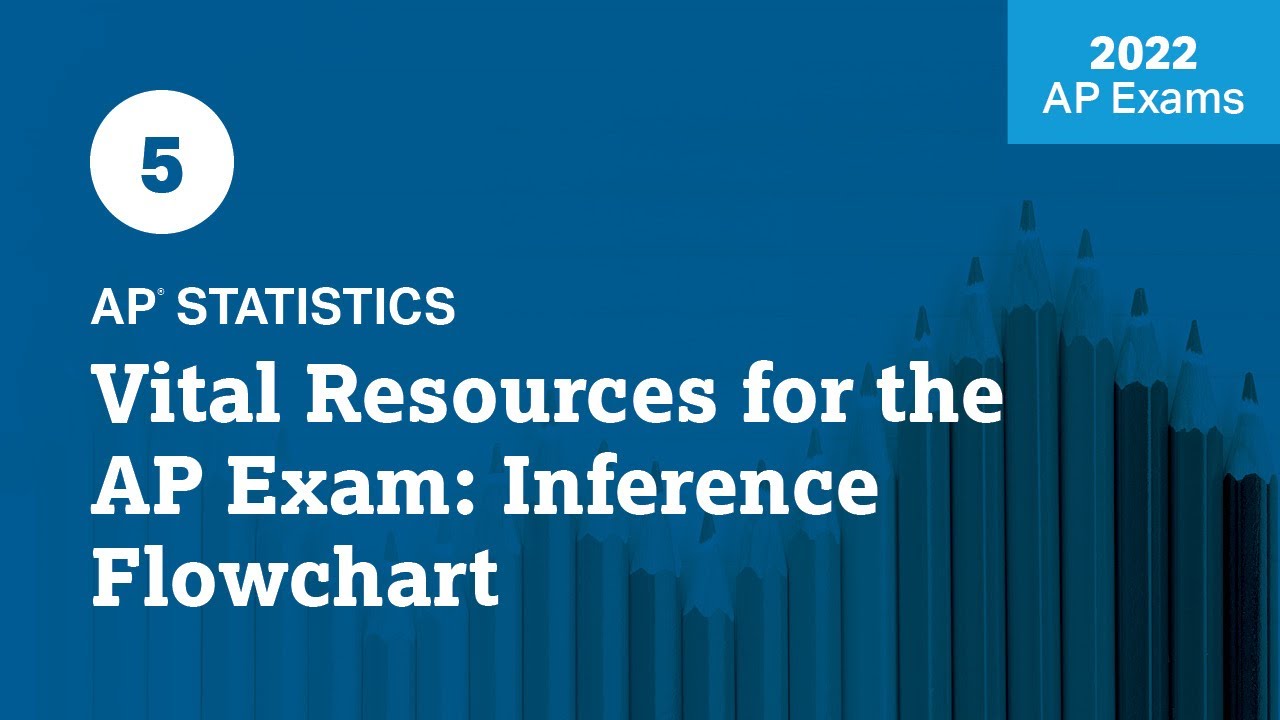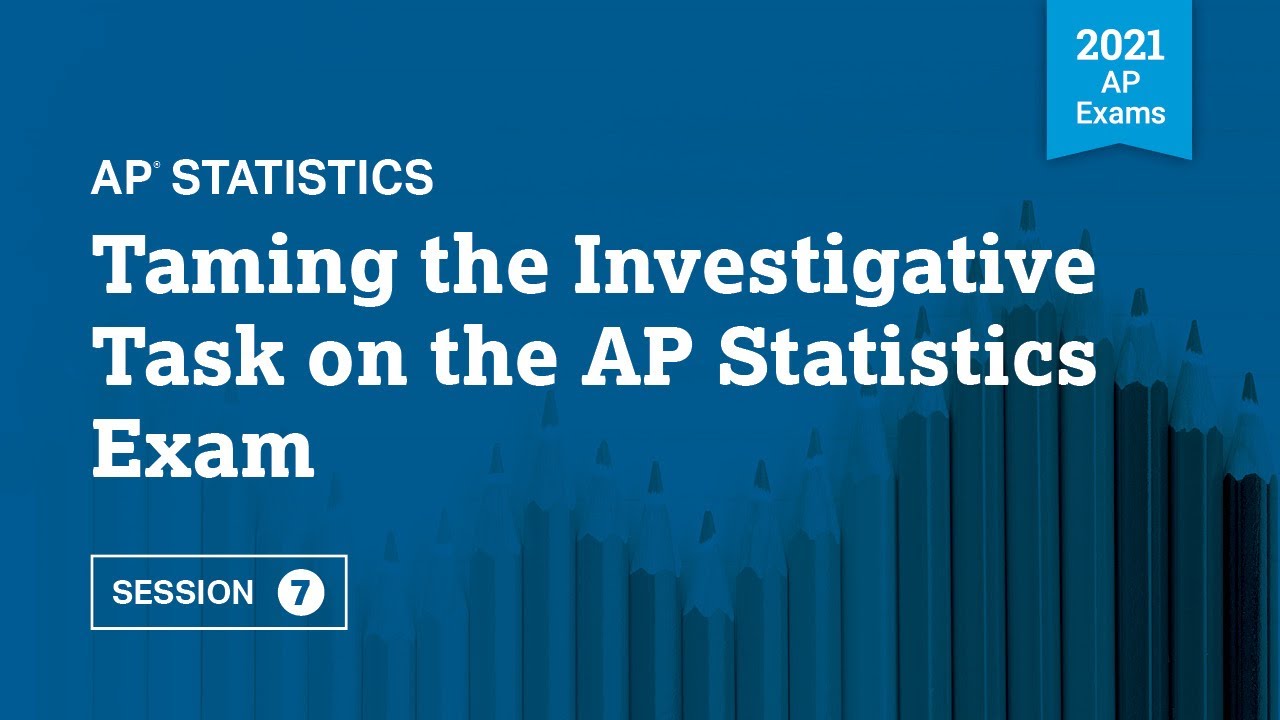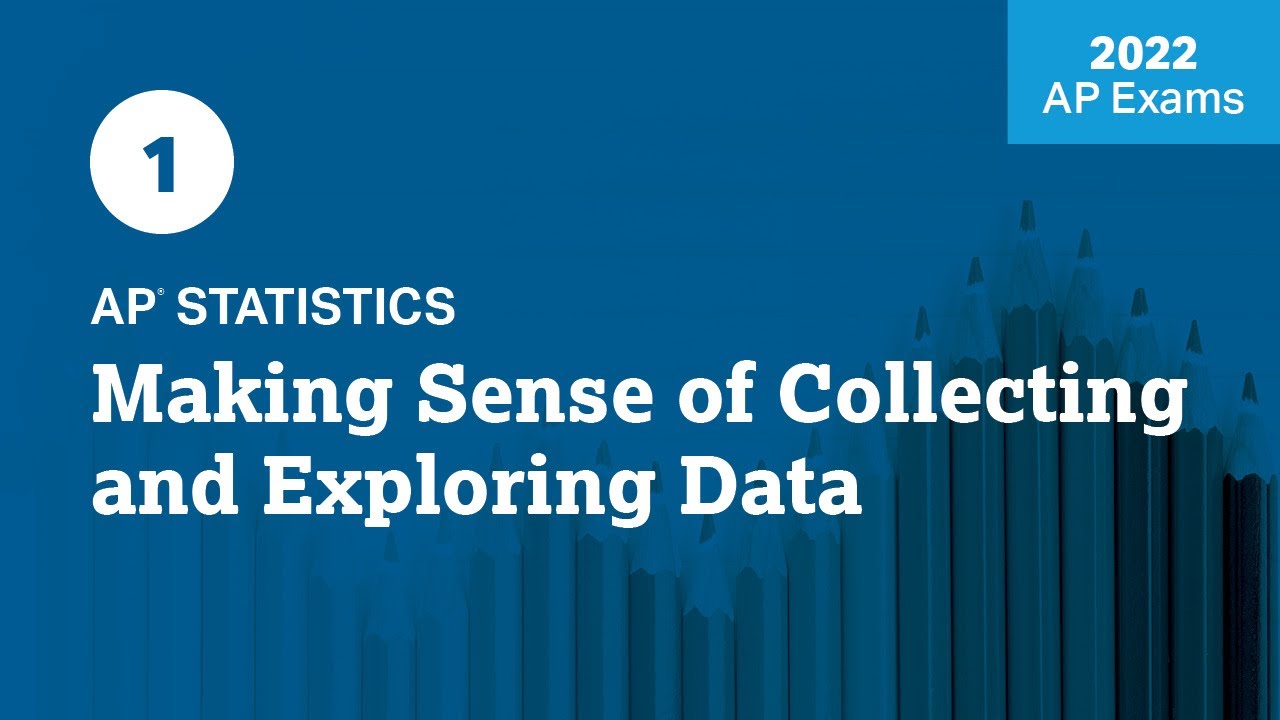2021 Live Review 5 | AP Statistics | Essential Tools Inference Flowchart, Formula Sheet & Calculator
TLDRIn this AP Statistics review session, teacher Luke Wilcox introduces three key tools for exam success: the inference flowchart for identifying statistical tests, the formula sheet for essential calculations, and the graphing calculator for efficient problem-solving. The session includes strategies to tackle challenging content, practice problems to apply these tools, and a focus on building students' confidence for the AP exam. Feedback is encouraged to enhance future sessions.
Takeaways
- 📚 The session is part of an AP Statistics review course, focusing on strategies to succeed in the AP exam.
- 👨🏫 The instructor, Luke Wilcox, is an AP Stats teacher at East Kentwood High School, and he co-plans the review sessions with Mr. Starnes.
- 🔍 The review sessions are structured to shift from challenging content to exam-specific strategies, aiming to increase students' scores.
- 📈 The session includes an 'Inference Flow Chart' to help students quickly identify the type of statistical inference required for a given question.
- 📝 The importance of the formula sheet and tables provided for the AP exam is emphasized, as they are key tools for exam success.
- 🔢 The session covers how to use the graphing calculator effectively during the exam, including specific functions and menus relevant to statistics.
- 📉 The instructor discusses the use of a spreadsheet to guide students to additional AP Daily videos for topics they might need more help with.
- 📉 Practice problems are utilized throughout the session to reinforce learning, including multiple-choice and free-response questions.
- 📝 The session's handouts, formula sheets, and additional resources are available through a Google Folder linked in the video description.
- 🤝 The instructor encourages student feedback to improve future sessions and asks viewers to give a thumbs up if they find the session helpful.
- 🎯 The overall goal of the review sessions is to simplify challenging content, share strategies for AP exam success, and build students' confidence.
Q & A
What is the main focus of the AP Statistics review session presented by Luke Wilcox?
-The main focus of the session is to provide strategies for success on the AP Statistics exam, including the use of tools like the inference flow chart, formula sheet, and graphing calculator.
What is the purpose of the inference flow chart mentioned in the session?
-The purpose of the inference flow chart is to help students quickly identify the type of confidence interval or significance test required for a given question.
What are the four key questions that students should ask themselves when faced with an inference question according to Luke Wilcox?
-The four key questions are: 1) Is it a special case? 2) Is it in the world of proportions or means? 3) How many samples or groups are there? 4) Is it a significance test or a confidence interval?
How can students find additional help on specific topics from the AP Statistics review sessions?
-Students can find additional help by referring to the spreadsheet provided, which directs them to specific AP Daily videos for further assistance on topics they struggled with.
What is the significance of the formula sheet in the context of the AP Statistics exam?
-The formula sheet is a crucial tool for the AP Statistics exam as it provides students with the necessary formulas for descriptive statistics, probability distributions, and inferential statistics.
How is the graphing calculator used as a tool for success on the AP Statistics exam?
-The graphing calculator is used to perform calculations for statistical problems, such as finding summary statistics, regression lines, and performing significance tests or confidence intervals.
What is the importance of the feedback loop at the end of each session in the AP Statistics review series?
-The feedback loop is important as it allows the instructors to understand the effectiveness of the session and make improvements for future sessions based on student responses.
What is the primary goal of the three main strategies presented in the session for AP exam success?
-The primary goal of the three main strategies is to simplify challenging content, share strategies for AP exam success, and build overall student confidence by the end of the review.
How does the session plan to utilize practice problems to reinforce learning?
-The session plans to utilize practice problems by going through multiple-choice and free-response questions that students can engage with, which helps in applying the strategies discussed.
What is the role of the chi-squared test in the context of the special cases for inference procedures?
-The chi-squared test is used when the problem involves a table of counts or categorical variables, indicating a relationship between two categorical variables.
How can students ensure they are using the correct significance test or confidence interval for a given problem?
-Students can ensure they are using the correct procedure by following the inference flow chart and asking the four key questions that guide them through the process of elimination to the appropriate test or interval.
What is the correct approach to finding the standard error of the difference between two sample means?
-The correct approach is to use the formula for the standard error of the difference between two means, which is the square root of (s1^2/n1 + s2^2/n2), where s1 and s2 are the standard deviations of the two samples, and n1 and n2 are the respective sample sizes.
How does the session facilitate the learning of the binomial distribution and its application to probability problems?
-The session facilitates learning by discussing the binomial distribution formula, providing examples of how to calculate probabilities using both the formula and the calculator's binomialcdf function.
What are the key functions on the calculator that students should be familiar with for the AP Statistics exam?
-Key functions include one variable statistics, line of regression, tcdf, normalcdf, chi-squared cdf, binomialcdf, and the tests menu for various significance tests and confidence intervals.
How can the formula sheet assist students in constructing and interpreting a confidence interval for the difference in means?
-The formula sheet provides the general formula for a confidence interval and the specific formula for the standard error of the difference between means, which students can use to construct the interval and interpret the results.
What is the process for students to submit their answers to the multiple-choice questions presented in the session?
-Students can submit their answers through a Google Form, which can be accessed via a tiny URL provided during the session or found in the session handout.
What is the significance of the thumb's up on YouTube for the AP Statistics review sessions?
-The thumb's up on YouTube helps to increase the visibility of the sessions, bringing the sessions to the attention of more AP Statistics students who can benefit from them.
Outlines
📚 Starting Week Two with AP Statistics Review
Luke Wilcox, an AP Stats teacher, introduces the second week of AP Daily Live Review for AP Statistics. He mentions a meeting with Mr. Starnes to plan the week's sessions, promising valuable content for students. The focus shifts from challenging content to AP exam strategies. Viewers are directed to a Google folder for session materials, including a handout and formula sheet, which are key to the week's success. Feedback from the first week is addressed, and a spreadsheet is provided to help students with specific topics. The session's plan includes discussing three main tools for AP exam success and practicing multiple-choice and free-response questions.
🔍 Tools for Success: Inference Flow Chart and Practice Problems
The session continues with an overview of tools for AP exam success, starting with the Inference Flow Chart. This chart guides students through four questions to identify the type of inference procedure needed for exam questions. Two special cases, inference for slope and chi-squared tests, are discussed. The flow chart is used to determine whether the question involves proportions, means, the number of samples or groups, and whether it's a significance test or a confidence interval. Practice problems are presented, allowing students to apply the flow chart and four questions to identify the correct statistical test for given scenarios.
📘 Understanding the Formula Sheet for AP Exam Success
The importance of the formula sheet provided during the AP exam is emphasized. It is organized into sections on descriptive statistics, probability distributions, and sampling distributions with inferential statistics. The formula sheet includes formulas for mean, standard deviation, correlation, and various probability distributions like binomial and geometric. It also contains general formulas for standardized test statistics and confidence intervals, with specific formulas available on the next page. Tables for normal, t, and chi-square distributions are included for reference. The session highlights the necessity of knowing the organization of the formula sheet and which formulas are most relevant for the exam.
📝 Utilizing the Graphing Calculator for Exam Problems
The session discusses the use of the graphing calculator during the AP exam, highlighting its functions for one-variable statistics, line of regression, and various significance tests and confidence intervals. The menu for distribution functions, including normalcdf, tcdf, and chi-squared cdf, is introduced. The presenter explains how these functions correspond to the tables provided on the formula sheet, allowing for quick calculations of areas under different distributions. The importance of knowing the calculator's capabilities is stressed to enhance exam performance.
🎯 Applying Strategies and Tools in Practice Problems
The presenter applies the strategies and tools discussed in the session to practice problems. Students are encouraged to submit their answers via a Google form. The first problem involves calculating the standard error of the difference between the means of two samples. The presenter uses the formula sheet to find the correct formula and demonstrates the calculation process. The second problem involves a binomial distribution, where the probability of winning a prize in a carnival game is calculated using the binomial probability formula. The presenter emphasizes the importance of identifying the correct distribution and using the appropriate formula for the solution.
📊 Engaging with the Calculator for Statistical Tests
The session focuses on using the calculator for statistical tests, explaining the process of finding p-values using the t-distribution. The presenter guides students through a problem where a t-test statistic is given, and the task is to find the corresponding p-value. The steps include using the tcdf function on the calculator with the given test statistic and degrees of freedom. The presenter demonstrates how to input the values into the calculator and interpret the result, which is used to select the closest p-value from the provided answer choices.
🔢 Calculator Application in Binomial Distribution Problems
The presenter uses the calculator to solve a binomial distribution problem involving the probability of getting heads when a coin is flipped a certain number of times. The problem requires finding the probability of getting 15 or fewer heads in 25 flips. The presenter explains the use of the binomialcdf function on the calculator, inputs the number of trials, probability of success, and the value for which the cumulative probability is sought. The result is interpreted to select the correct answer choice from the options provided.
🛠️ Combining Tools for a Comprehensive Free Response Question
The session concludes with a free response question that combines all the strategies and tools discussed. The question involves constructing and interpreting a 95% confidence interval for the difference in mean response times between two fire stations. The presenter uses the inference flow chart to identify the correct inference procedure, refers to the formula sheet for the necessary formula, and employs the calculator to compute the confidence interval. The presenter emphasizes the importance of understanding the process, checking conditions, using the correct formula, and interpreting the interval to achieve full credit on the AP exam.
👍 Seeking Feedback and Encouraging Engagement
Luke Wilcox wraps up the session by seeking feedback from students to improve future sessions. He provides a link for feedback and encourages students to give a thumbs up on YouTube if the session was helpful. This feedback will inform the planning of upcoming sessions. The presenter also thanks the students for their participation and looks forward to the next session with Mr. Starnes, who will discuss the rubrics for free response questions.
Mindmap
Keywords
💡AP Statistics
💡Inference Flow Chart
💡Formula Sheet
💡Graphing Calculator
💡Significance Test
💡Confidence Interval
💡Chi-Squared Test
💡Binomial Distribution
💡Normal Distribution
💡T-Distribution
💡Free Response Question
Highlights
Introduction to the AP Statistics live review session, emphasizing the importance of attending all sessions for a comprehensive understanding.
Shift in focus from challenging content to AP exam strategies, aiming to increase students' scores.
Availability of session materials through a provided URL, including handouts and formula sheets crucial for exam success.
Introduction of a spreadsheet to guide students on which AP Daily videos to reference for additional help on specific topics.
Emphasis on the use of a graphing calculator as a tool for success on the AP exam, with suggestions to have it handy during the session.
Overview of the session's plan to cover three key tools for AP exam success: inference flow chart, formula sheet, and calculator.
Explanation of the inference flow chart, a method to quickly identify the type of inference procedure required for a given question.
Practice problems to apply the four questions of the inference flow chart for identifying the correct statistical test.
Discussion on the importance of the formula sheet provided during the AP exam and strategies for its effective use.
Clarification on the organization of the formula sheet into three sections: descriptive statistics, probability distributions, and inferential statistics.
Practice of using the formula sheet to calculate the standard error of the difference between two sample means.
Illustration of how to use the calculator for one-variable statistics to find mean, standard deviation, and the five-number summary.
Demonstration of using the calculator for two-variable data to find the equation of the line of best fit.
Explanation of the calculator functions for significance tests and confidence intervals, crucial for various statistical analyses.
Guidance on using calculator functions for normal, t, and chi-squared distributions to find areas under the curves.
Practice problem involving the use of the calculator to find the p-value for a given t-test statistic.
Application of all three tools—flow chart, formula sheet, and calculator—to construct and interpret a 95% confidence interval for the difference in mean response times.
Summary of strategies for AP exam success, including choosing the correct inference procedure, knowing the formula sheet, and effectively using the calculator.
Call to action for student feedback to improve future sessions and a reminder of the importance of engagement for better learning outcomes.
Transcripts
Browse More Related Video

2022 Live Review 5 | AP Statistics | Vital Resources for the AP Exam: Inference Flowchart

2021 Live Review 7 | AP Statistics | Taming the Investigative Task on the AP Statistics Exam

2022 Live Review 2 | AP Statistics | Making Sense of Probability & Random Variables

2021 Live Review 1 | AP Statistics | How to Explore and Collect Data

2021 Live Review 8 | AP Statistics | Top 10 Tips for Success on the AP Statistics Exam

2022 Live Review 1 | AP Statistics | Making Sense of Collecting and Exploring Data
5.0 / 5 (0 votes)
Thanks for rating: